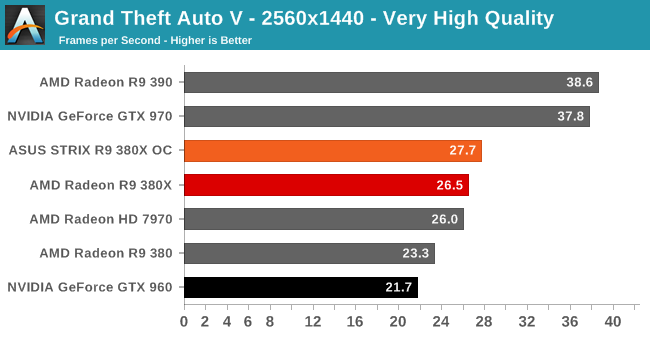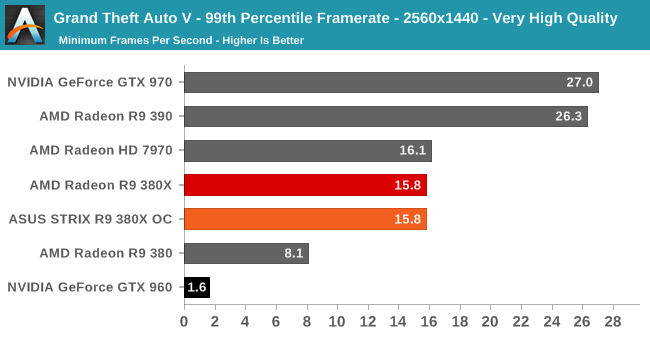The AMD Radeon R9 380X Review, Feat. ASUS STRIX
by Ryan Smith on November 23, 2015 8:30 AM EST- Posted in
- GPUs
- AMD
- Radeon
- Asus
- Radeon 300
Grand Theft Auto V
The open world action game in our benchmark suite is also the last game in our suite: Grand Theft Auto V. The latest edition of Rockstar’s venerable series of open world games, Grand Theft Auto V was originally released to the last-gen consoles back in 2013. However thanks to a rather significant facelift for the current-gen consoles and PCs, along with the ability to greatly turn up rendering distances and add other features like MSAA and more realistic shadows, the end result is a game that is still among the most stressful of our benchmarks when all of its features are turned up.
On a quick note about settings, as Grand Theft Auto V doesn't have pre-defined settings tiers, I want to quickly note what settings we're using. For "Very High" quality we have all of the primary graphics settings turned up to their highest setting, with the exception of grass, which is at its own very high setting. Meanwhile 4x MSAA is enabled for direct views and reflections. This setting also involves turning on some of the advanced redering features - the game's long shadows, high resolution shadows, and high definition flight streaming - but not increasing the view distance any further.


Grand Theft Auto V is another game that punishes 2GB cards to a degree, which plays into the R9 380X’s favor. At 1080p this helps to keep the card 11% ahead of the GTX 960 and 5% ahead of the R9 380. That said, GTA is the one game where perhaps even the R9 380X isn’t powerful enough for no-compromises 1080p gaming, and while 38fps is more than playable (this was a 30fps console game), the 60fps PC standard will require giving up MSAA to hit that mark.


Meanwhile the 99th percentile framerates further drive home the point about 2GB cards being insufficient. However it also points out how even the R9 380X can’t stay above 30fps at all times, reiterating what we said above about possibly needing to drop MSAA to get the best 1080p performance on the R9 380X.










101 Comments
View All Comments
CaedenV - Monday, November 23, 2015 - link
Card idle so low now that it does not make much of a difference. Even leaving my 4 year old monster on 24/7 is costing me maybe $10-15/year, and with the improved idle power load on newer cards (I am running a 570), it would probably cut that in half.Not to say that you should go crazy and leave things on all of the time because it 'does not matter'... but unless you are running something with a 24/7 load like a render box or a server, then power costs is not a true consideration. Heat generation due to an inefficient card may be a consideration, but not the price of the power used.
rviswas - Monday, November 23, 2015 - link
i was gonna say difference between gtx 860 and this card is less than 5w at idle is says in the review itself look at power consumption.rviswas - Monday, November 23, 2015 - link
gts 960 I meanChaser - Monday, November 23, 2015 - link
Use your AMD GPU to help heat your home. Spoken like a true AMD apologist. LOLlooncraz - Monday, November 23, 2015 - link
Except he's running an nVidia card.Dribble - Monday, November 23, 2015 - link
Too close in price to the 970/390. Anyone spending that much will stretch the extra few $ for the much faster card. Price/performance isn't good enough - needs to be $200.Beany2013 - Tuesday, November 24, 2015 - link
Except when you literally can't afford those extra $ - IE in the UK, the 380X starts around £190, the 970 starts around £250 (using Overclockers.co.uk as a reference).The cost difference there, if all you're doing is upgrading a GPU, is significant enough where you can't really say 'ooh, it's only a little more' - if we were talking £190 and £220, that'd be different.
Likewise, if you're configuring a whole system, and aren't an *avid* gamer (IE, as a survey of one, I mostly dick about in Serious Sam 3 and Metro 2033/Last Light - both of which are far better with a chunky GPU if you like your shiny goodness) then the £60 difference is better spent elsewhere, like RAM, storage, or a larger monitor.
Horses for courses, but if you're trying to eke out as much overall value as possible for a machine without horribly compromising on performance, AMD make a hell of a lot of sense.
Me? I'm waiting for Fiji to come down below £200. And, you know, to get a new job. Which'd probably help, natch.
AndrewJacksonZA - Monday, November 23, 2015 - link
Re: "Finally, we’re also unable to include compute benchmarks for R9 380X at reference clocks, as AMD’s drivers do not honor underclocking options with OpenCL programs."Would someone please be so kind as to explain "underclocking options with OpenCL programs" to me please? Why do the cards need to be underclocked when running OpenCL programs?
Thank you.
Ryan Smith - Monday, November 23, 2015 - link
The card we received is the STRIX R9 380X OC, which comes with a factory overclock of 1030MHz, versus 970MHz for a reference card. We underclock this to get reference performance, however underclocking doesn't work with OpenCL programs.AndrewJacksonZA - Monday, November 23, 2015 - link
OK, got it, thanks Ryan.